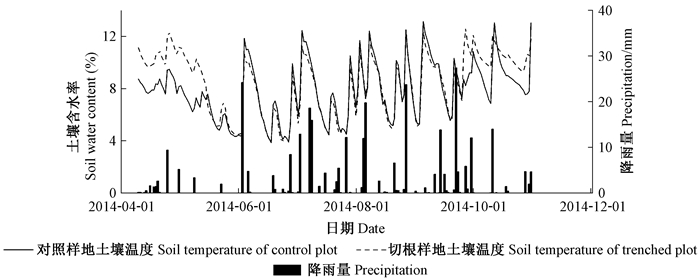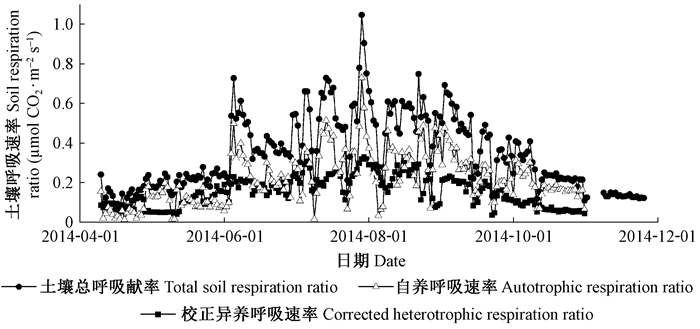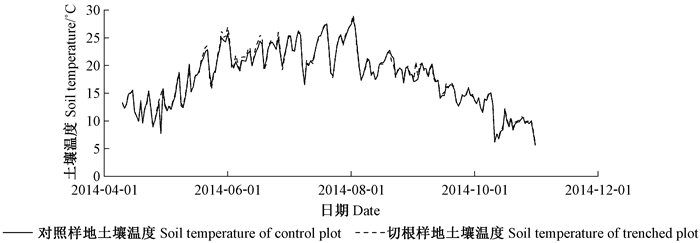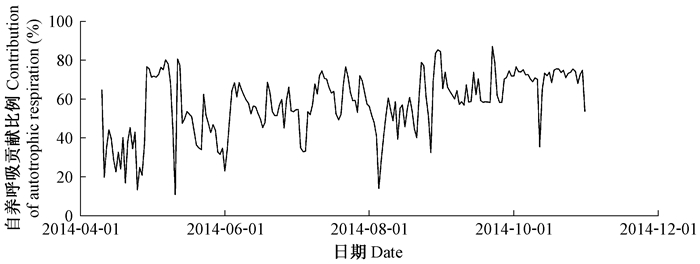文章信息
- 刘鹏, 贾昕, 杨强, 查天山, 王奔, 马景永
- Liu Peng, Jia Xin, Yang Qiang, Zha Tianshan, Wang Ben, Ma Jingyong
- 毛乌素沙地油蒿灌丛生态系统的土壤呼吸特征
- Characterization of Soil Respiration in a Shrubland Ecosystem of Artemisia ordosica in Mu Us Desert
- 林业科学, 2018, 54(5): 10-17.
- Scientia Silvae Sinicae, 2018, 54(5): 10-17.
- DOI: 10.11707/j.1001-7488.20180502
-
文章历史
- 收稿日期:2016-07-21
- 修回日期:2018-03-16
-
作者相关文章
土壤呼吸是陆地生态系统与大气间碳交换的第二大通量组分,其任何微小变化都将显著影响大气CO2浓度(Schlesinger et al., 2000)。干旱半干旱地下碳储量占全球地下总碳库的1/4,在全球碳循环过程中起着重要作用(Jia et al., 2014; Poulter et al., 2014)。探究干旱半干旱区土壤呼吸动态变化及其调控机制,对于准确估算全球碳收支至关重要。
目前对干旱半干旱区土壤呼吸影响因子的报道较少,尤其对土壤呼吸不同组分(自养呼吸速率RA,异养呼吸速率RH)调控机制的研究更为少见(Knorr et al., 2005; Davidson et al., 2006)。尽管学界普遍认可土壤温湿度是土壤呼吸的主要影响因子,然而不同呼吸组分对环境因子的响应往往存在差异,加之温度与水分的交互作用(Li et al., 2006; Yan et al., 2015; Wang et al., 2014),使得土壤呼吸过程更为复杂。因此,分别剖析土壤呼吸不同组分对环境因子的响应有助于深入理解其调控机理。此外,已有研究表明,植物物候和土壤微生物群落组成结构影响土壤呼吸的温度敏感性(Q10)(Janssens et al., 2003; Davidson et al., 2006; Monson et al., 2006; 刘立新等,2007)。然而,对土壤呼吸不同组分Q10的认识仍存争论。一些研究发现RA对温度的响应比RH更为敏感(Luo et al., 2010; Shi et al., 2012),另一些研究发现RA的Q10低于RH(Högberg, 2010; Poulter et al., 2014),或与RH的Q10相似(Yan et al., 2015)。因此,需要进一步开展关于干旱半干旱区RA和RH对温度、水分变化响应的研究(Chen et al., 2003; 王新源等,2012)。
自养呼吸贡献率(RA占土壤总呼吸速率RT的比例)是陆地生态系统碳平衡和土壤有机碳周转的关键参数,对预测气候变化对土壤碳过程的影响具有重要意义。已有关于RA/RT的研究多集中在北方森林、温带草原和农田生态系统(Hanson et al., 2000; 李凌浩等,2002),而在半干旱区灌丛生态系统的研究较少。RA/RT在不同气候区和生态系统间变异很大,如高纬度地区RA/RT可高达62%~89%,而农田生态系统仅为12%~28%(李凌浩等,2002)。这为预测大尺度土壤碳循环带来了极大的不确定性。
本研究以宁夏盐池典型油蒿(Artemisia ordosica)灌丛生态系统为研究对象,采用切根法剖分RA与RH,利用自动气室法对切根处理与对照样地的土壤呼吸速率进行连续观测,阐明RA/RT在季节尺度和日尺度的动态,揭示土壤温湿度对土壤呼吸速率的影响规律,为预估半干旱区土壤碳排放提供科学依据。
1 研究区概况研究地点位于宁夏盐池荒漠生态系统定位研究站(107°13′ 37″E,37°42′ 31″ N,海拔1 550 m),地处毛乌素沙地南缘,是黄土高原向鄂尔多斯台地、半干旱向干旱区、干草原向荒漠草原过渡的生态交错带。属于典型的中温带大陆性季风气候,年均气温7.6 ℃,多年平均降水量280 mm,其中68%的降水集中在7—9月(数据来源于盐池县气象站,为1954—2012年的平均值)。土壤以风沙土为主,土壤密度(0~10 cm土层)为(1.54±0.08) g ·cm-3。土壤有机碳含量(0~10 cm土层)为(13.7±0.11)g·kg-1,土壤全氮含量(0~10 cm土层)为(0.12±0.03)g·kg-1,pH值为8.62±1.60。样地田间持水量为13%,优势种为油蒿,根系分布至土深30~40 cm处。
2 研究方法 2.1 样地设置2013年8月选取地势平坦、生长较好的油蒿群落,布设1块10 m×10 m样地。样地内植被高度约为50 cm,平均冠幅约为80 cm×60 cm,植被盖度约为37%。为剖分土壤呼吸组分,在样地内随机设置2组PVC环,每组3个。第1组PVC环高53 cm,直径23 cm,为切根处理,打入土壤50 cm以确保切断根系;第2组PVC环高10 cm,直径23 cm,设置为对照,打入土壤7 cm。切根处理所测的土壤表面碳通量代表RH,对照所测土壤表面碳通量代表RT。
2.2 土壤呼吸速率与环境因子测定2014年4—10月(样地布设后8个月,避免切根处理土壤残留根系的分解造成试验误差)利用ACE(ADC Inc., UK)土壤呼吸自动观测系统对样地内的土壤呼吸进行观测。每次测量时间为5 min,测量间隔为20 min。测定土壤呼吸速率的同时,利用ACE自带的温度水分传感器探头同步测定10 cm深度的土壤温度(Ts)和土壤含水率(SWC)。切根处理会显著增加土壤含水率(图 1),从而导致试验误差,因此,采用Saiz等(2007)的指数二次方程对RH和土壤温湿度的关系进行拟合:
| $ {R_{\rm{H}}} = a{{\rm{e}}^{b{T_{\rm{s}}}}}(c{\rm{SW}}{{\rm{C}}^2} + d{\rm{SWC}}){\rm{。}} $ | (1) |

|
图 1 土壤含水率与降雨量的季节变化 Figure 1 Seasonal variation of soil water content and precipitation |
式中:a、b、c、d为拟合参数。
根据对照组Ts和SWC估算出异养呼吸速率校正值(RH')。土壤自养呼吸速率(RA)可估算为RT- RH'。校正异养呼吸速率RH'主要用于计算RA和展示土壤呼吸组分的季节动态变化(图 3),实测异养呼吸速率(RH)主要用于分析RH与土壤温湿度之间的关系。

|
图 3 土壤呼吸速率的季节变化 Figure 3 Seasonal variation of soil respiration |
采用如下方程对Ts与土壤呼吸速率关系进行拟合:
| $ {R_{\rm{S}}} = {R_{10}}Q_{10}^{\left({{T_{\rm{S}}} - 10} \right)/10}{\rm{。}} $ | (2) |
式中:RS为土壤呼吸速率;R10为土温为10 ℃时的土壤呼吸速率;Q10为温度敏感性。
为减小随机误差的影响,在拟合方程(2)时首先利用原始数据计算小时数据,然后以0.3 ℃为间隔,对Ts和土壤呼吸小时数据进行分段平均(bin-average)。为避免降雨激发效应(Birch et al., 1958)导致的非平衡态影响,在拟合方程(2)时剔除降雨期间数据。此外,为检验土壤呼吸的温度响应是否受到水分调节,同时为避免植物物候的影响,分析仅选取生长季中期(6—8月)数据,并以8%作为SWC阈值将数据分为2组然后分别拟合方程(2),Wang等(2014)的研究结果表明当SWC小于8%,土壤呼吸速率主要受土壤湿度调控,而与土壤温度间没有显著的统计关系。采用线性回归拟合土壤呼吸温度响应函数的残差(观测值/预测值)与SWC的关系,用以检验土壤呼吸的水分依赖性。
采用重复测量方差分析(ANOVA)检验切根样地与对照样地之间Ts和SWC的差异。统计分析均使用Matlab R2 014 a(the Mathworks Inc., USA)完成。
3 结果与分析 3.1 土壤呼吸速率与环境因子的季节变化研究区降水集中在6—9月,该期降水量为262.3 mm,占生长季总降雨量的82%。10 cm深处SWC随降水呈周期性波动(图 1)。切根处理的SWC显著高于对照(均值分别为9.3%和8.4%, P=0.03),而切根对Ts无显著影响(均值分别为17.9和18 ℃, P > 0.05,图 2)。

|
图 2 土壤温度的季节变化 Figure 2 Seasonal variation of soil temperature |
RT在4月份缓慢增加,在8月6日达到最大值(1.36 mmol CO2 ·m-2 s-1),之后缓慢降低(图 3);RA的变化曲线与RT基本一致,在8月达到最大值(1.04 mmol CO2 ·m-2 s-1);RH’季节变化趋势近似单峰曲线,在8月达到最大值(0.33 mmol CO2 ·m-2 s-1),之后缓慢降低(图 3)。
RA/RT在整个生长季的值为60.1%,且存在明显的季节变化(图 4)。RA/RT在4月保持在较低的水平(均值为37%),5—8月均值为54%,在8月底有明显的上升趋势,9—10月变化较为平缓(> 60%)。

|
图 4 自养呼吸贡献率的季节变化 Figure 4 Seasonal variation of contribution of autotrophic respiration to total soil respiration |
Ts存在明显的昼夜变化,在6:00—8:00达到最小值,15:00达到最大值。此外,不同SWC条件下,土壤呼吸速率及其组分的昼夜变化存在差异。当SWC≤8%时(图 5),土壤呼吸速率及其组分与Ts表现为非同步变化,RT与RH峰值出现的时间(11:00和14:00)均早于Ts(15:00),而RA存在午休现象,即在11:00达到最大值,随后下降,在14:00达到最小值;当SWC > 8 %时(图 5),RT,RH与Ts变化基本同步,从8:00开始增加,在15:00达到最大值,随后下降,虽然RA也存在“午休”现象,但是其降低程度较小。

|
图 5 不同土壤含水率下土壤呼吸速率、土壤温度及自养呼吸贡献率日变化 Figure 5 Diel variations in soil respiration rate, soil temperature and the contribution of autotrophic respiration under different soil water contents |
夜间的RA/RT高于白天。当SWC≤8%时(图 5),RA/RT的变化曲线类似“V”字形,在14:00达到最小值(29.6%),RA/RT的日均值为47%。当SWC > 8%时(图 5),RA/RT较高(日均值为63%),在中午(12:00)受到抑制而下降,在15:00达到最小值(57.8%)。
3.3 土壤呼吸速率对土壤温度和土壤含水率的响应在季节尺度,土壤呼吸速率随Ts增加而指数增长。RH对温度最为敏感,其次为RT和RA(图 6)。Ts对RA季节变异的解释率(55%)远低于RT与RH(> 80%)。Ts与SWC存在显著的二次多项式关系(P < 0.05,图 7)。RT和RA的温度响应受SWC影响。当SWC≤8%时,RT与RA对Ts的变化并不敏感(表 1);当SWC >8%时,Ts能够很好地解释RT与RA的动态变化(R2 > 0.8),RT与RA的Q10均有所增加(表 1)。RH对Ts的响应受SWC的影响很小(表 1)。RA温度响应的残差(观测值/预测值)与SWC存在显著的线性关系(图 8,P < 0.05),不同SWC条件下RH温度响应的残差均与SWC无显著相关关系(图 8)。

|
图 6 生长旺季(6—8月)土壤呼吸速率对土壤温度的响应 Figure 6 Responses of soil respiration rate to temperature during the peak growing season (Jun.-Aug.) |

|
图 7 生长旺季(6—8月)土壤含水率对土壤温度的响应c Figure 7 Responses of soil water content to temperature during the peak growing season (Jun.-Aug.) |
|
|

|
图 8 土壤呼吸速率温度响应函数残差(观测值/预测值)对土壤含水率的响应 Figure 8 Responses of the residuals derived from the relationship between soil respiration rate and soil temperature (observed values/predicted values) to changes in soil water content |
本研究结果表明,在日尺度与季节尺度上,土壤温湿度对RA与RH的影响存在差异。在日尺度,RA存在午休现象,与Ts不同步变化,而RH与Ts基本同步变化。这表明在日尺度,RA受Ts的影响较小,而RH主要受Ts调节。受正午强烈辐射和高温影响,植物气孔关闭,光合作用受到抑制,可供呼吸利用的底物降低,根系呼吸受到抑制,造成RA在正午之前就达到峰值,随后下降(Zhang et al., 2010),这种趋势在干旱时更加明显。一些已有研究也发现日尺度上RA可能并不受土壤温度的调节(Liu et al., 2006)。RH主要受Ts、SWC和呼吸底物(土壤中可分解有机质)的调节(Giardina et al., 2000; Jassal et al., 2008)。其中SWC与呼吸底物的日变化一般较为微弱,难以对RH产生影响(Gaumont-Guay et al., 2006),RH的昼夜变化主要受Ts的影响。
在季节尺度,RH主要受温度影响并且对温度的变化比RA更为敏感(图 6),而RA对温度的响应受到水分影响。当SWC≤8%时,RA受Ts与SWC的共同调控;当SWC > 8%时,RA主要受Ts调控,其Q10与R10均有所增加(表 1)。土壤呼吸的Q10受到多个因子的影响。近期研究表明,呼吸底物与植物物候期的季节变化是土壤呼吸Q10的重要影响因素(Högberg, 2010; Kuzyakov et al., 2010)。Wang等(2015)研究表明油蒿群落土壤呼吸可利用的底物量在生长季中期达到最大值。此外,土壤水分可以通过改变土壤呼吸底物的可利用性和呼吸底物的扩散能力来影响土壤呼吸(Wang et al., 2014;2015)。本研究并未发现SWC对RH存在显著影响(图 8),这可能是因为异养微生物的代谢过程受水分影响较小,对干旱的耐受能力较强。而植物的光合作用在土壤干旱时容易受到抑制,降低光合产物,减少自养呼吸可利用的底物(Gaumont-Guay et al., 2008),从而抑制RA对温度的响应。此外,本研究发现在土壤水分条件较好时(SWC > 8%),RH的R10降低(表 1)。
4.2 自养呼吸速率对土壤总呼吸速率的贡献本研究油蒿灌丛生态系统生长季自养呼吸速率对土壤总呼吸速率的贡献率为60.1%。已有研究表明,土壤自养呼吸对土壤总呼吸的贡献率在不同生态系统间差异较大:温带森林生态系统为30%~70% (Andrews et al., 1999),温带草原生态系统与农田生态系统分别为17%~40%和12%~28%(李凌浩等,2002)。和以上研究相比,本研究结果处于较高的位置,这可能与本地区土壤养分及有机质缺乏、土壤微生物生物量低而植物根系较发达有关(Feng et al., 2014)。
RA/RT在日尺度与季节尺度上存在明显的动态变化。在日尺度上,RA/RT存在午休现象。已有研究证实RA/RT主要受植物光合影响(Högberg et al., 2001)。RA/RT的午休现象很可能是由于中午叶片气孔关闭,光合作用受到抑制,自养呼吸底物供应下降所致。在季节尺度,RA/RT在4月较低,在5—8月比较稳定而在9—10月较高。而之前一些研究发现RA/RT在5—8月较高(张金池等,2010)。这可能是因为试验地的土壤温湿度不同且植物的生长节律存在差异。此外,土壤呼吸组分对土壤温湿度的敏感性不同也会导致RA/RT的季节变化(Kirschbaum, 1995)。本研究中RA/RT在9—10月较高,可能是因为9、10月迅速降低的Ts对RA的影响小于对RH的影响。
5 结论土壤呼吸组分在季节尺度与日尺度上对环境因子的响应均存在差异。在日尺度上,RA受Ts的影响较小;而RH则主要受Ts调控。在季节尺度上,RH比RA对温度的变化更为敏感,主要受Ts的调控,而RA对Ts的响应受到SWC的调节。RA/RT在日尺度与季节尺度上的动态变化很可能来源于呼吸组分对环境因子的差异响应。
以油蒿为建群种的群落是毛乌素沙地最为典型的植被类型之一,其生态系统的碳收支平衡对实现荒漠化逆转与增强生态系统碳汇等至关重要。本研究揭示了油蒿灌丛生态系统土壤呼吸组分在日尺度与季节尺度上对土壤温湿度的响应机制,为准确预估未来气候变化引起的温度升高对油蒿群落土壤碳排放的影响提供了个例研究。未来还需更长时间尺度(年际尺度)的监测研究以实现油蒿群落生态系统碳收支的准确预估,为沙区植被恢复管理提供科学依据。
李凌浩, 韩兴国, 王其兵, 等. 2002. 锡林河流域一个放牧草原群落中根系呼吸占土壤总呼吸比例的初步估计[J]. 植物生态学报, 26(1): 29-32. (Li L H, Han X G, Wang Q B, et al. 2002. Separating root and soil microbial contributions to total soil respiration in a grazed grassland in the Xilan River Basin[J]. Acta Phytoecologica Sinica, 26(1): 29-32. [in Chinese]) |
刘立新, 董云社, 齐玉春, 等. 2007. 应用根去除法对内蒙古温带半干旱草原根系呼吸与土壤总呼吸的区分研究[J]. 环境科学, 28(4): 689-694. (Liu L X, Dong Y S, Qi Y C, et al. 2007. Study of distinguish root respiration from total soil respiration by root exclusion method in the temperate semi-arid grassland in Inner Mongolia, China[J]. Environmental Science, 28(4): 689-694. [in Chinese]) |
王新源, 李玉霖, 赵学勇, 等. 2012. 干旱半干旱区不同环境因素对土壤呼吸影响研究进展[J]. 生态学报, 32(15): 4890-4901. (Wang X Y, Li Y L, Zhao X Y, et al. 2012. Responses of soil respiration to different environment factors in semi-arid and arid areas[J]. Acta Ecologica Sinica, 32(15): 4890-4901. [in Chinese]) |
张金池, 孔雨光, 王因花, 等. 2010. 苏北淤泥质海岸典型防护林地土壤呼吸组分分离[J]. 生态学报, 30(12): 3144-3154. (Zhang J C, Kong Y G, Wang Y H, et al. 2010. Components separation of soil respiration in two typical shelter forestlands in silting coastal area, Northern Jiangsu Province[J]. Acta Ecologica Sinica, 30(12): 3144-3154. [in Chinese]) |
Andrews J A, Harrison K G, Matamala R, et al. 1999. Seperation of root respiration from total soil respiration using carbon-13 labeling during free-air carbon dioxide enrichment[J]. Soil Science Society of America Journal, 63(2-4): 1429-1435. |
Birch H F. 1958. The effect of soil drying on humus decomposition and nitrogen availability[J]. Plant & Soil, 10(1): 9-31. |
Chen Q, Li L, Han X, et al. 2003. Acclimatization of soil respiration to warming[J]. Acta Ecologica Sinica, 24(11): 2649-2655. |
Davidson E A, Janssens I A. 2006. Temperature sensitivity of soil carbon decomposition and feedbacks to climate change[J]. Nature, 440(7081): 165-173. DOI:10.1038/nature04514 |
Feng W, Zhang Y, Jia X, et al. 2014. Impact of environmental factors and biological soil crust types on soil respiration in a desert ecosystem[J]. Plos One, 9(7): e102954. DOI:10.1371/journal.pone.0102954 |
Gaumont-Guay D, Black T A, Griffis T J, et al. 2006. Interpreting the dependence of soil respiration on soil temperature and water content in a boreal aspen stand[J]. Agricultural and Forest Meteorology, 140(1): 220-235. |
Gaumont-Guay D, Black T A, Barr A G, et al. 2008. Biophysical controls on rhizospheric and heterotrophic components of soil respiration in a boreal black spruce stand[J]. Tree Physiology, 28(2): 161-171. DOI:10.1093/treephys/28.2.161 |
Giardina C P, Ryan M G. 2000. Evidence that decomposition rates of organic carbon in mineral soil do not vary with temperature[J]. Nature, 404(6780): 858-861. DOI:10.1038/35009076 |
Hanson P J, Edwards N T, Garten C T, et al. 2000. Separating root and soil microbial contributions to soil respiration: a review of methods and observations[J]. Biogeochemistry, 48(1): 115-146. DOI:10.1023/A:1006244819642 |
Högberg P. 2010. Is tree root respiration more sensitive than heterotrophic respiration to changes in soil temperature?[J]. New Phytologist, 188(1): 9-10. DOI:10.1111/j.1469-8137.2010.03366.x |
Högberg P, Nordgren A, Buchmann N, et al. 2001. Large-scale forest girdling shows that current photosynthesis drives soil respiration[J]. Nature, 411(6839): 789-792. DOI:10.1038/35081058 |
Jassal R S, Black T A, Novak M D, et al. 2008. Effect of soil water stress on soil respiration and its temperature sensitivity in an 18-year-old temperate Douglas-fir stand[J]. Global Change Biology, 14(6): 1305-1318. DOI:10.1111/j.1365-2486.2008.01573.x |
Janssens I A, Pilegaard K I M. 2003. Large seasonal changes in Q10 of soil respiration in a beech forest[J]. Global Change Biology, 9(6): 911-918. DOI:10.1046/j.1365-2486.2003.00636.x |
Jia X, Zha T S, Wu B, et al. 2014. Biophysical controls on net ecosystem CO2 exchange over a semiarid shrubland in northwest China[J]. Biogeosciences, 11(17): 4679-4693. DOI:10.5194/bg-11-4679-2014 |
Kirschbaum M U F. 1995. The temperature dependence of soil organic matter decomposition and effect of global warming on soil organic C storage[J]. Soil Biology and Biochemistry, 27(27): 753-760. |
Knorr W, Prentice I C, House J I, et al. 2005. Long-term sensitivity of soil carbon turnover to warming[J]. Nature, 433(7023): 298-301. DOI:10.1038/nature03226 |
Kuzyakov Y, Gavrichkova O. 2010. Time lag between photosynthesis and carbon dioxide efflux from soil: a review of mechanisms and controls[J]. Global Change Biology, 16(12): 3386-3406. DOI:10.1111/j.1365-2486.2010.02179.x |
Li Y Q, Xu M, Zou X M. 2006. Heterotrophic soil respiration in relation to environmental factors and microbial biomass in two wet tropical forests[J]. Plant and Soil, 281(1/2): 193-201. |
Liu Q, Edwards N T, Post W M, et al. 2006. Temperature-independent diel variation in soil respiration observed from a temperate deciduous forest[J]. Global Change Biology, 12(11): 2136-2145. DOI:10.1111/gcb.2006.12.issue-11 |
Luo Y, Zhou X. 2010. Deconvolution analysis to quantify autotrophic and heterotrophic respiration and their temperature sensitivities[J]. New Phytologist, 188(1): 10-11. DOI:10.1111/j.1469-8137.2010.03425.x |
Monson R K, Lipson D L, Burns S P, et al. 2006. Winter forest soil respiration controlled by climate and microbial community composition[J]. Nature, 439(7077): 711-714. DOI:10.1038/nature04555 |
Poulter B, Frank D, Ciais P, et al. 2014. Contribution of semi-arid ecosystems to inter-annual variability of the global carbon cycle[J]. Nature, 509(7502): 600-603. DOI:10.1038/nature13376 |
Saiz G, Black K, Reidy B, et al. 2007. Assessment of soil CO2 efflux and its components using a process-based model in a young temperate forest site[J]. Geoderma, 139(1): 79-89. |
Schlesinger W H, Andrews J A. 2000. Soil respiration and the global carbon cycle[J]. Biogeochemistry, 48(1): 7-20. DOI:10.1023/A:1006247623877 |
Shi W Y, Zhang J G, Yan M J, et al. 2012. Seasonal and diurnal dynamics of soil respiration fluxes in two typical forests on the semiarid Loess Plateau of China: temperature sensitivities of autotrophs and heterotrophs and analyses of integrated driving factors[J]. Soil Biology and Biochemistry, 52(3): 99-107. |
Wang B, Zha T S, Jia X, et al. 2014. Soil moisture modifies the response of soil respiration to temperature in a desert shrub ecosystem[J]. Biogeosciences, 11(2): 259-268. DOI:10.5194/bg-11-259-2014 |
Wang B, Zha T S, Jia X, et al. 2015. Microtopographic variation in soil respiration and its controlling factors vary with plant phenophases in a desert-shrub ecosystem[J]. Biogeosciences, 12(19): 5705. DOI:10.5194/bg-12-5705-2015 |
Yan M, Guo N, Ren H, et al. 2015. Autotrophic and heterotrophic respiration of a poplar plantation chronosequence in northwest China[J]. Forest Ecology and Management, 337(337): 119-125. |
Zhang L H, Chen Y N, Zhao R F, et al. 2010. Significance of temperature and soil water content on soil respiration in three desert ecosystems in Northwest China[J]. Journal of Arid Environments, 74(10): 1200-1211. DOI:10.1016/j.jaridenv.2010.05.031 |
 2018, Vol. 54
2018, Vol. 54

